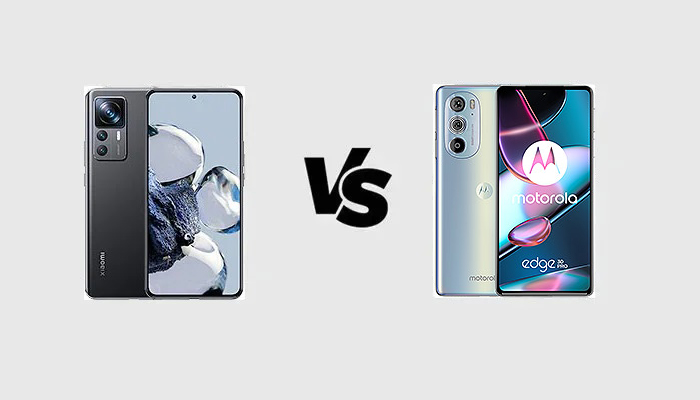The Xiaomi 12T Pro is definitely one of the most advanced flagship killers of the second half of 2022. Its price is not the most affordable, but it is not even the most expensive. Despite that, this is a phone with an outstanding camera and the best Qualcomm chipset out there, as well as one of the fastest charging technologies in the whole market. Is it enough to make it the best flagship out there in terms of value for money? We think there is no better way to understand it than comparing it to the most impressive flagship killers released by other brands. Here is a comparison between the main specifications of the Xiaomi 12T Pro and the Motorola Edge 30 Pro. The Edge 30 Pro is currently one of the most affordable flagship killers with top-tier hardware you can buy in the global market, that is the reason why it is the perfect rival of the new Xiaomi flagship. Here you will learn which one suits your needs the most.

Xiaomi 12T Pro vs Motorola Edge 30 Pro
| Xiaomi 12T Pro | Motorola Edge 30 Pro | |
|---|---|---|
| DIMENSIONS AND WEIGHT | 163.1 x 75.9 x 8.6 mm, 205 g |
163.1 x 76 x 8.8 mm, 196 g |
| DISPLAY | 6.67 inches, 1220 x 2712 pixels (Full HD+), AMOLED | 6.7 inches, 1080 x 2400p (Full HD+), OLED |
| PROCESSOR | Qualcomm Snapdragon 8+ Gen 1, octa-core 3.19 GHz | Qualcomm Snapdragon 8 Gen 1, octa-core 3 GHz |
| MEMORY | 8 GB RAM, 128 GB – 8 GB RAM, 256 GB – 12 GB RAM, 256 GB | 8 GB RAM, 128 GB – 8 GB RAM, 256 GB – 12 GB RAM, 256 GB – 8 GB RAM, 512 GB |
| SOFTWARE | Android 12, MIUI | Android 12 |
| CONNECTIVITY | Wi-Fi 802.11 a/b/g/n/ac/ax, Bluetooth 5.2, GPS | Wi-Fi 802.11 a/b/g/n/ac/6e, Bluetooth 5.2, GPS |
| CAMERA | Triple 200 + 8 + 2 MP, f/1.7 + f/2.2 + f/2.4 Single 20 MP f/2.2 front camera |
Triple 50 + 50 + 2 MP, f/1.8 + f/2.2 + f/2.4 Single 60 MP f/2.2 |
| BATTERY | 5000 mAh, Fast charging 120W | 4800 mAh, Fast Charging 68W and fast wireless charging 15W |
| ADDITIONAL FEATURES | 5G, dual SIM | 5G, dual SIM |
Design
Despite being high-end phones, the Xiaomi 12T Pro and the Motorola Edge 30 Pro do not come with the most beautiful designs, but they are not ugly phones. These phones are built with glass backs and they sport very high screen to body ratios, thanks to narrow bezels around the displays. The Motorola Edge 30 Pro looks to have a more minimalistic look, with a camera module sporting the same color as the rest of the rear cover. These are not thin and lightweight phones because they pack above-average batteries, and they are not compact phones as well. An important added value of the Xiaomi 12T Pro is the presence of the IP53 certification making it dust resistant and splashproof, but the Motorola Edge 30 Pro has a water repellent design, so it offers some protection against water allowing you to use it under the rain. For the rest, follow your tastes and choose which one is the best for you consequently.
Display
The displays of these two phones belong to the same range, but on paper, it looks like the Xiaomi 12T Pro has a more advanced panel. It is an AMOLED display with a diagonal of 6.67 inches able to show up to 68 billion colors with a Full HD+ resolution of 1220 x 2712 pixels, a 120 Hz refresh rate, HDR10 certification, Dolby Vision support, and a peak brightness of 900 nits. It also comes with an in-display fingerprint reader and stereo speakers. The Motorola Edge 30 Pro has an OLED display able to show up to one billion colors with a diagonal of 6.7 inches, a Full HD+ resolution of 1080 x 2400 pixels, a 144 Hz refresh rate, and HDR10+ certification. The phone has stereo speakers and, despite its panel being an OLED, the biometric sensor is not in-display but it has a side-mounted fingerprint reader.
Specs & Software
If your goal is to get the most advanced hardware department, then you should opt for the Xiaomi 12T Pro. It is powered by a more powerful processor: the Snapdragon 8+ Gen 1. It is currently the best processor by Qualcomm, built with a 4 nm production process and with an octa-core architecture composed of a Cortex X2 CPU running at a max frequency of 3.19 GHz, three Cortex A710 CPUs running at 2.75 GHz, four Cortex A510 CPUs running at 2 GHz, and an Adreno 730 GPU. Alongside the chipset, there are up to 12 GB of LPDDR5 RAM and up to 256 GB of UFS 3.1 internal storage. The Motorola Edge 30 Pro is fueled by the Snapdragon 8 Gen 1 built with a 4 nm production process and sporting an octa-core architecture composed of a Cortex X2 core running at 3 GHz, three Cortex A710 cores running at 2.5 GHz, four Cortex A510 cores running at 1.8 GHz, and an Adreno 730 GPU. It is paired with up to 12 GB of RAM and up to 512 GB of UFS 3.1 native storage. Both phones run Android 12 out of the box, but with different user interfaces on top.
Camera
If you love to shoot normal photos and you are looking for the best main camera, choose the Xiaomi 12T Pro because it is one of the world’s first phones with a 200 MP shooter, including OIS support. But if you want better ultrawide shots, then you should go for the Motorola Edge 30 Pro because it comes with a 50 MP main camera and another 50 MP camera for ultrawide photos. Further, the Edge 30 Pro has a better front camera with a 60 MP resolution.
Battery
The Xiaomi 12T Pro packs a bigger battery and it guarantees longer battery life in several scenarios. It even charges quicker but, unlike the Motorola Edge 30 Pro, it lacks wireless charging.
Price
The Motorola Edge 30 Pro is available for less than €700/$700 globally, while the Xiaomi 12T Pro starts from €900/$900. Which one would you pick?
Xiaomi 12T Pro vs Motorola Edge 30 Pro: PRO and CONS
Xiaomi 12T Pro
PRO
- Better chipset
- Bigger battery
- Faster charging
- IP53 certification
- Better main camera
CONS
- Price
Motorola Edge 30 Pro
PRO
- Wireless charging
- Better ultrawide camera
- More affordable
- Up to 512 GB of storage
- Better front camera
CONS
- Nothing particular
RELATED
- iPhone SE vs iPhone 13 mini: Specs Comparison
- Vivo X Fold+ vs Samsung Galaxy Z Fold4: Specs Comparison
- Google Pixel 6 Pro vs iPhone 13 Pro Max: Specs Comparison
- iPhone 14 Plus vs Google Pixel 7 Pro: Specs Comparison
Check the latest videos from our YouTube channel and subscribe:
*Please Note: When you buy something using the links in our articles, we may earn a small commission at no cost to you.






